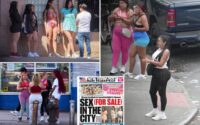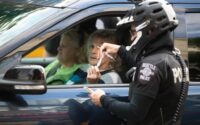NYC congestion scanners installed as NJ sues over ‘toll shopping’
It’s coming! New York has started installing toll radars on the West side of Manhattan to start charging congestion fees by Spring, but the New Jersey governor is fighting back.
New cashless systems are already popping up in the busy metropolitan that will charge commuters anywhere between $9 and $23 to enter the Big Apple come May.
Contractors were seen installing these radars along 61st Street and West End Avenue on Friday morning and more will be popping up all across the city from 60th Street down.
Congestion pricing is expected to go into effect in the Spring, but the Garden State is fighting back.
New Jersey Governor Phil Murphy, 65, filed a lawsuit against the federal government in hopes of blocking the installations, which he claimed the feds short-circuited the traditional review process.
However, MTA Chairman Janno Lieber said the transportation agency “got the federal environmental approval.”
“We’ve started that installation as we’ve also started to build out the software, and what we call the back-office system for capturing toll information and generating bills and so on,” Lieber said at a Wednesday press conference.

Murphy, however, accused New York of “toll shopping” on Friday and claimed it would cause commuters to find different routes into the city to “avoid paying higher tolls, resulting in more traffic and more pollution.”
“We are particularly disappointed in the lack of a thorough environmental review and lack of mitigation measures for impacted communities,” Murphy said on Friday. “Their finding that the MTA congestion pricing program will not have any significant impacts is an error.”
Murphy called the tolls “anti-environmental, anti-commuter, and anti-business.”
“@USDOT and @USDOTFHWA have unlawfully fast-tracked the @MTA’s attempt to line its coffers at the expense of New Jersey families. We stand united against the unjust taxation of our residents,” he wrote on Twitter.

The MTA is operating the toll radars. The company’s Traffic Mobility Review Board met on Wednesday to discuss the edition to the streets.
Board member Carl Weisbrod said: “If we give a full credit for crossing, then we’re not dealing with congestion at all from the west.”
However, many are asking for exemptions to the tolls – including taxi and rideshare drives, like Uber and Lyft – but the board says there will be very few offered, as the goal is to encourage commuters to take public transportation systems into the city.

But residents aren’t exactly happy with the new development, with Upper West Side resident Lauren Mandel questioning why the city is installing cameras on both sides of the street, when only those traveling South of 60th Street should be charged when it goes into effect.
“People will be completely confused because they won’t even know if it took effect, and they will be going all the way north or all the way south, or other boroughs just to bypass it, and it’s going to wreak havoc,’ she told CBS News.
Others, including Mandel, wondered why the radars are being put up already when it won’t go into effect until May.

“I don’t think they should have done that because it may not go through, still there is a chance it may not go through. They may have wasted some money,” Martha Buckner told CBS News.
However, at least one resident, Howard Robinson, is fine with the proposed toll, telling the outlet: “More people should ride bikes, and there really isn’t room for cars in Manhattan anyway.”
The toll radars – which cost $507 million to design, build, and operate – will be located around Lincoln and Holland Tunnels coming from New Jersey, and Ed Koch Queensboro Bridge, Queens-Midtown Tunnel, Williamsburg Bridge, Manhattan Bridge, Brooklyn Bridge, and the Hugh L. Carey Tunnel in the boroughs, according to the MTA.
There will be 120 detection points across both the West and East sides of the island.


